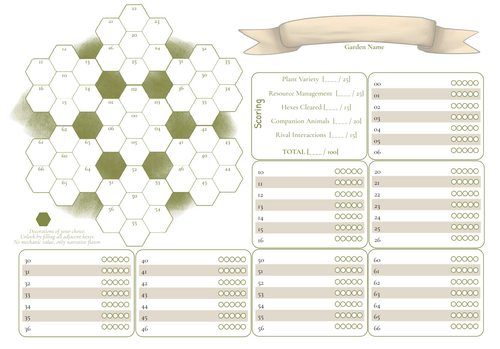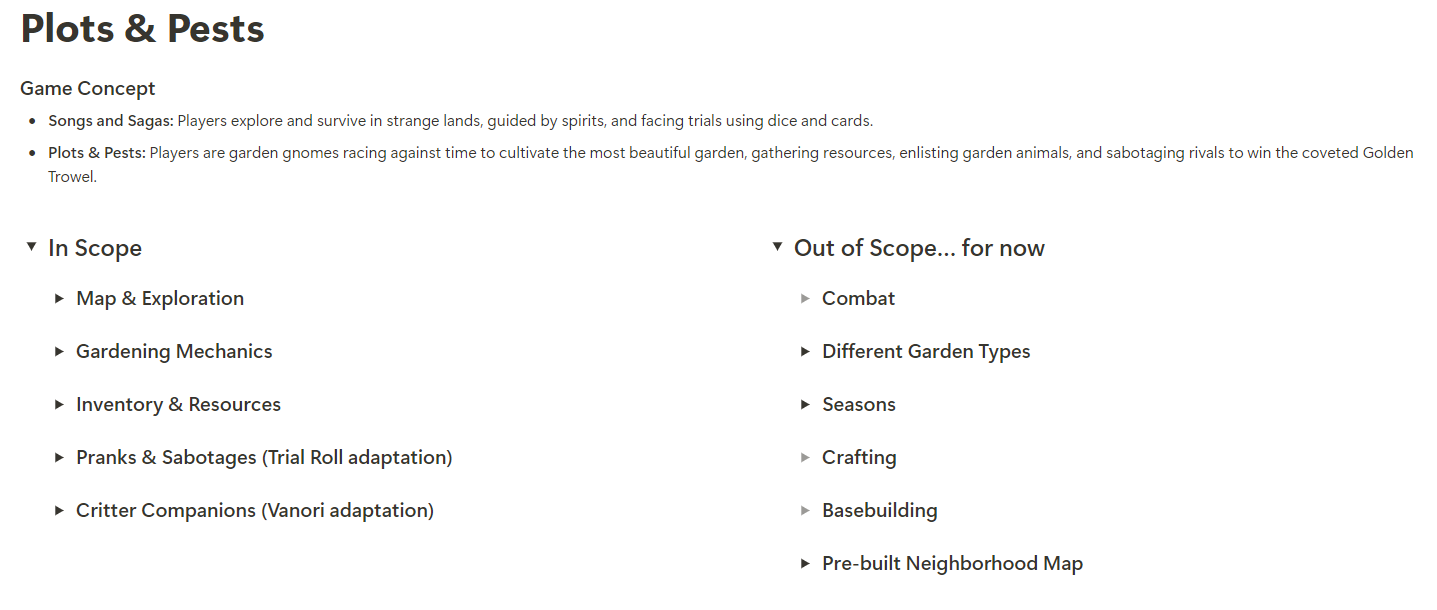Plots & Pests - From Garden Beds to Gnome Pranks

Development Process
The game started as a passion project for the Songs & Sagas Jam, but it quickly became something larger. Over the course of development, we trimmed away ideas that didn’t quite fit, like base-building mechanics and crafting, to focus more on the core gameplay of gardening, exploration, and rivalries. We knew from the start this would be a zine-style project, so we worked within those limits to try and avoid feature creep. Having a solid structure for what the game should be (thanks to the Songs & Sagas SRD) kept us focused.
When we first started developing Plots & Pests, we knew we wanted to create something cozy and light-hearted, while still offering enough strategic depth to keep solo players engaged.
Inspiration
Our initial inspiration came from a mix of genres—garden simulators, solo RPGs, and a sprinkle of mischievous fantasy elements. Games like Apothecaria and Stardew Valley gave us the cozy gardening vibes we wanted, but we also wanted to add a competitive twist to the peaceful gameplay. Something a little more Plants vs Zombies. Hence, rival gnomes!

Designing Around a Cozy World
One of the first decisions was the aesthetic. We leaned heavily into the garden-based theme, where everything, from companion animals to magical plant seeds, could be discovered and nurtured. Plots & Pests invites players to have fun in a low-pressure environment, where mistakes (like failed pranks) are part of the charm rather than punishing moments.
The game’s loop—managing your garden while dealing with rivals—needed to be simple enough for casual play, but flexible enough to provide variety in every session. The game unfolds in phases (Morning, Afternoon, and Evening), where each phase offers different activities. This structure allows players to balance gardening tasks with exploration and mischief. We introduced companion animals to provide mechanical benefits (and a dash of cuteness) without overwhelming the player with too many choices.
The scoring system was an area where we wanted transparency and fairness. We didn’t want players to feel that they had to “game the system” too hard to win, so we offered clear criteria. In a solo game you are your own judge of how well you played, while in gnome vs. gnome duo/group play you are welcome to troll each other a little in the judging.
Challenges and Choices
One of the biggest challenges was balancing the rivals’ system. We wanted rival gnomes to feel competitive but not frustrating. We initially played around with more complex mechanics, but it felt too heavy for what we were going for. In the end, we simplified it into pranks and sabotages, where the fun lies in beating rivals without resorting to bloodshed.
We also wanted the game to feel replayable. By tying randomness into seed discovery, animal companions, and exploration events, we aimed for each playthrough to feel different.
What's Next
While Plots & Pests stands on its own, we have many ideas we’d like to see realized. There’s a lot of potential for expanding into different garden types, seasons, or even crafting systems. These ideas fell out of scope for the initial release, but with enough community interest, we’d love to revisit and expand the game.
For now, we’re focusing on supporting the game, gathering feedback, and working on our next projects—This Drowning Fury (ecological and survival horror), Feylands Travel Inc (cozy journaling), and Roadkill and Revelations (supernatural horror).
FAQ
Q: How do I know what plants to grow in each hex? A: Each hex has specific sunlight and soil conditions determined by card draws. Match the conditions with your plant's needs (listed in the seed packet table) to speed up growth. If the hex’s conditions don’t match the plant’s needs, the plant will take the full 5 days to grow. However, if conditions match, you can reduce the growth cycle to just 3 days.
Q: Can I explore more than one hex per day? A: Yes, as long as you have enough Resilience. Each hex exploration uses 1 Resilience point, so if you have multiple points available, you can explore multiple hexes in one turn.
Q: How do I win the game? A: At the end of 30 days, your garden will be evaluated based on several categories: plant variety, resource management, cleared hexes, and animal companions. Aim to score the highest possible points in each category to receive the Guild’s highest honor.
Q: Can I recruit more than one animal companion? A: Yes, you can recruit multiple animals, up to 13 different companions. Each animal provides a unique skill, and you’ll need to strategize when to use their abilities, as deploying an animal costs Resilience.
Q: How often can I use animal abilities? A: Animal abilities can be used once per day, and each use costs 1 (or 2 for more powerful animals) Resilience point.
Q: Can challenges spread to other hexes? A: Yes, certain challenges (like pests or waterlogging) may affect surrounding hexes. When this happens, draw a card for 1d3 adjacent hexes to see how far the issue spreads. Each hex affected will suffer from the same challenge.
Q: How do I clear a hex? A: To clear a hex, draw a card and consult the garden exploration rules. Depending on the card’s suit and value, you may face obstacles like pests or debris that must be cleared before the hex is usable.
Q: How often can I perform pranks or sabotage on rivals? A: You can perform pranks or sabotage every evening during the Resolution Phase, as long as you have enough Resilience to complete the task.
Q: Can I retry a failed prank or sabotage? A: No, you cannot retry the same prank or sabotage action in the same day. If you fail, your rival may retaliate based on the retaliation table, and you’ll have to wait until the next day to try again.
Q: How do I keep track of rival progress in solo mode? A: In solo mode, draw a progress card for each rival at the end of the day, unless you have successfully sabotaged them (which prevents them from gaining wellness that day). Use these draws to track how well your rivals are doing and adjust your strategies accordingly.
Q: Can I play the game again after I finish? A: Absolutely! The random elements of the game (like card draws and rival interactions) mean each playthrough will be different. Try experimenting with new strategies, plants, or animal companions to see if you can score higher on your next run.
Get Plots & Pests
Plots & Pests
Cozy TTRPG where gnomes race to grow the best garden while sabotaging rivals. Play solo/duo/small group.
| Status | Released |
| Category | Physical game |
| Author | LichLight Imprints |
| Tags | Cozy, Exploration, Gardening, role-playing-game, Solo RPG, songs-and-sagas, Tabletop, Tabletop role-playing game, Two Player |

Leave a comment
Log in with itch.io to leave a comment.